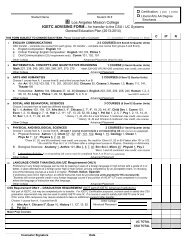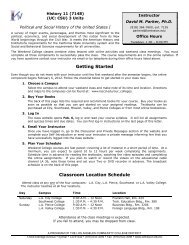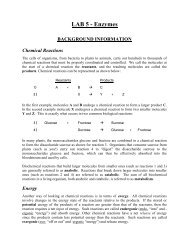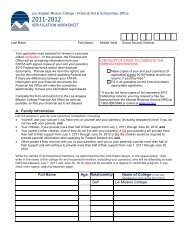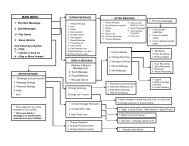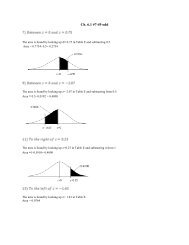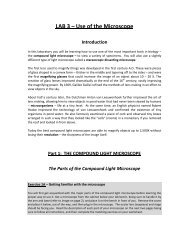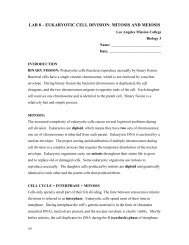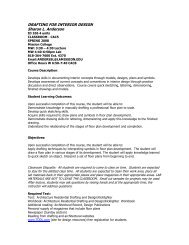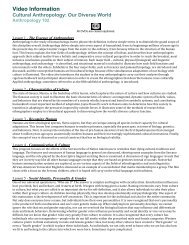Lab #6 - Cellular Respiration
Lab #6 - Cellular Respiration
Lab #6 - Cellular Respiration
You also want an ePaper? Increase the reach of your titles
YUMPU automatically turns print PDFs into web optimized ePapers that Google loves.
Part 1: FERMENTATION<br />
To produce ATP from glucose, whether by fermentation or cellular respiration, cells must first<br />
partially break it down by glycolysis (“sugar” “separation”). The enzymes involved in glycolysis<br />
are located in the cell cytoplasm and sequentially break down each 6-carbon molecule of<br />
glucose to two 3-carbon molecules of pyruvate. In the process, enough energy is extracted to<br />
produce 2 molecules of ATP.<br />
glucose (6-carbons) 2 pyruvate (3-carbons)<br />
energy<br />
2 ADP + 2 P i 2 ATP<br />
In conjunction with glycolysis, cells will carry out fermentation if there is no oxygen (O 2 )<br />
available. When you overexert yourself for example, your muscles do not receive enough<br />
oxygen and temporarily ferment glucose. In another familiar example, yeast will ferment when<br />
placed in an enclosed environment with a source of carbohydrate such as grapes (for making<br />
wine) or hops and barley (for making beer).<br />
Interestingly, fermentation does not produce any additional ATP. What it does do is regenerate<br />
an important molecule needed for a particular step in glycolysis. This molecule is the electron<br />
carrier NAD + , which if depleted will bring a halt to glycolysis and ATP production, resulting in cell<br />
death. Fermentation therefore contributes to ATP production indirectly by allowing glycolysis,<br />
and the production of 2 ATP per glucose, to continue unhindered.<br />
2 NAD + 2 NADH 2 NAD +<br />
2H - 2H -<br />
glucose 2 pyruvate 2 fermentation products<br />
2 ADP + 2 P i 2 ATP<br />
Glycolysis<br />
Fermentation<br />
As shown above, NAD + , an empty electron carrier, is converted to NADH, a full electron carrier<br />
(the electrons being “carried” are associated with the hydrogen atom) during glycolysis.<br />
Fermentation is simply one or more biochemical steps that transfer the H in NADH and an extra<br />
electron to a molecule of pyruvate. As a result, NADH is restored to NAD + , which is needed for<br />
glycolysis, and pyruvate is converted to a “fermentation product” which can be a variety of<br />
things depending on the organism.<br />
Animals, including human beings, produce lactic acid when their cells ferment. In organisms<br />
from other kingdoms the fermentation products can be quite different. Some bacterial species<br />
produce acetic acid (vinegar) when they ferment, whereas others produce acetone (the main<br />
ingredient in nail polish) or other organic molecules. In the Kingdom Fungi, single-celled yeasts



